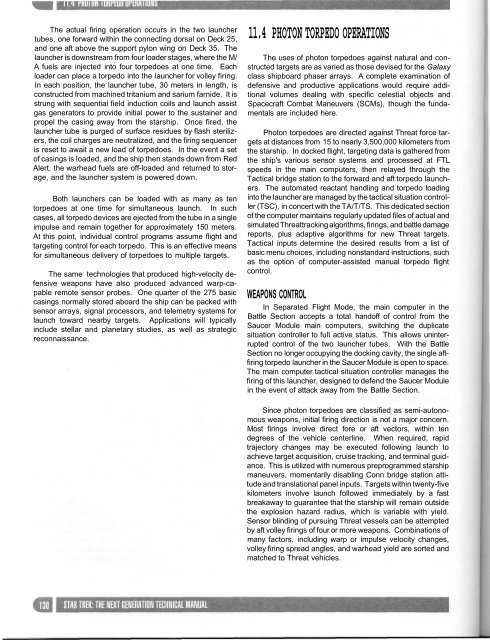franchise-star-trek-tng-technical-manual1
franchise-star-trek-tng-technical-manual1
franchise-star-trek-tng-technical-manual1
You also want an ePaper? Increase the reach of your titles
YUMPU automatically turns print PDFs into web optimized ePapers that Google loves.
The actual firing operation occurs in the two launchertubes, one forward within the connecting dorsal on Deck 25,and one aft above the support pylon wing on Deck 35. Thelauncher is downstream from four loader stages, where the M/A fuels are injected into four torpedoes at one time. Eachloader can place a torpedo into the launcher for volley firing.In each position, the launcher tube, 30 meters in length, isconstructed from machined tritanium and sarium farnide. It isstrung with sequential field induction coils and launch assistgas generators to provide initial power to the sustainer andpropel the casing away from the <strong>star</strong>ship. Once fired, thelauncher tube is purged of surface residues by flash sterilizers,the coil charges are neutralized, and the firing sequenceris reset to await a new load of torpedoes. In the event a setof casings is loaded, and the ship then stands down from RedAlert, the warhead fuels are off-loaded and returned to storage,and the launcher system is powered down.Both launchers can be loaded with as many as tentorpedoes at one time for simultaneous launch. In suchcases, all torpedo devices are ejected from the tube in a singleimpulse and remain together for approximately 150 meters.At this point, individual control programs assume flight andtargeting control for each torpedo. This is an effective meansfor simultaneous delivery of torpedoes to multiple targets.The same technologies that produced high-velocity defensiveweapons have also produced advanced warp-capableremote sensor probes. One quarter of the 275 basiccasings normally stored aboard the ship can be packed withsensor arrays, signal processors, and telemetry systems forlaunch toward nearby targets. Applications will typicallyinclude stellar and planetary studies, as well as strategicreconnaissance.11.4 PHOTON TORPEDO OPERATIONSThe uses of photon torpedoes against natural and constructedtargets are as varied as those devised for the Galaxyclass shipboard phaser arrays. A complete examination ofdefensive and productive applications would require additionalvolumes dealing with specific celestial objects andSpacecraft Combat Maneuvers (SCMs), though the fundamentalsare included here.Photon torpedoes are directed against Threat force targetsat distances from 15 to nearly 3,500,000 kilometers fromthe <strong>star</strong>ship. In docked flight, targeting data is gathered fromthe ship's various sensor systems and processed at FTLspeeds in the main computers, then relayed through theTactical bridge station to the forward and aft torpedo launchers.The automated reactant handling and torpedo loadinginto the launcher are managed by the tactical situation controller(TSC), in concert with the TA/T/TS. This dedicated sectionof the computer maintains regularly updated files of actual andsimulated Threattracking algorithms, firings, and battle damagereports, plus adaptive algorithms for new Threat targets.Tactical inputs determine the desired results from a list ofbasic menu choices, including nonstandard instructions, suchas the option of computer-assisted manual torpedo flightcontrol.WEAPONS CONTROLIn Separated Flight Mode, the main computer in theBattle Section accepts a total handoff of control from theSaucer Module main computers, switching the duplicatesituation controller to full active status. This allows uninterruptedcontrol of the two launcher tubes. With the BattleSection no longer occupying the docking cavity, the single aftfiringtorpedo launcher in the Saucer Module is open to space.The main computer tactical situation controller manages thefiring of this launcher, designed to defend the Saucer Modulein the event of attack away from the Battle Section.Since photon torpedoes are classified as semi-autonomousweapons, initial firing direction is not a major concern.Most firings involve direct fore or aft vectors, within tendegrees of the vehicle centerline. When required, rapidtrajectory changes may be executed following launch toachieve target acquisition, cruise tracking, and terminal guidance.This is utilized with numerous preprogrammed <strong>star</strong>shipmaneuvers, momentarily disabling Conn bridge station attitudeand translational panel inputs. Targets within twenty-fivekilometers involve launch followed immediately by a fastbreakaway to guarantee that the <strong>star</strong>ship will remain outsidethe explosion hazard radius, which is variable with yield.Sensor blinding of pursuing Threat vessels can be attemptedby aft volley firings of four or more weapons. Combinations ofmany factors, including warp or impulse velocity changes,volley firing spread angles, and warhead yield are sorted andmatched to Threat vehicles.


